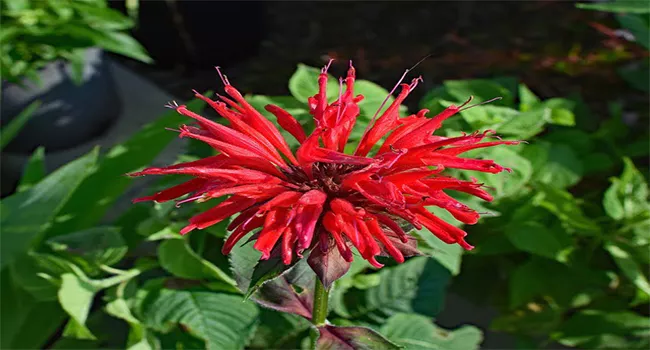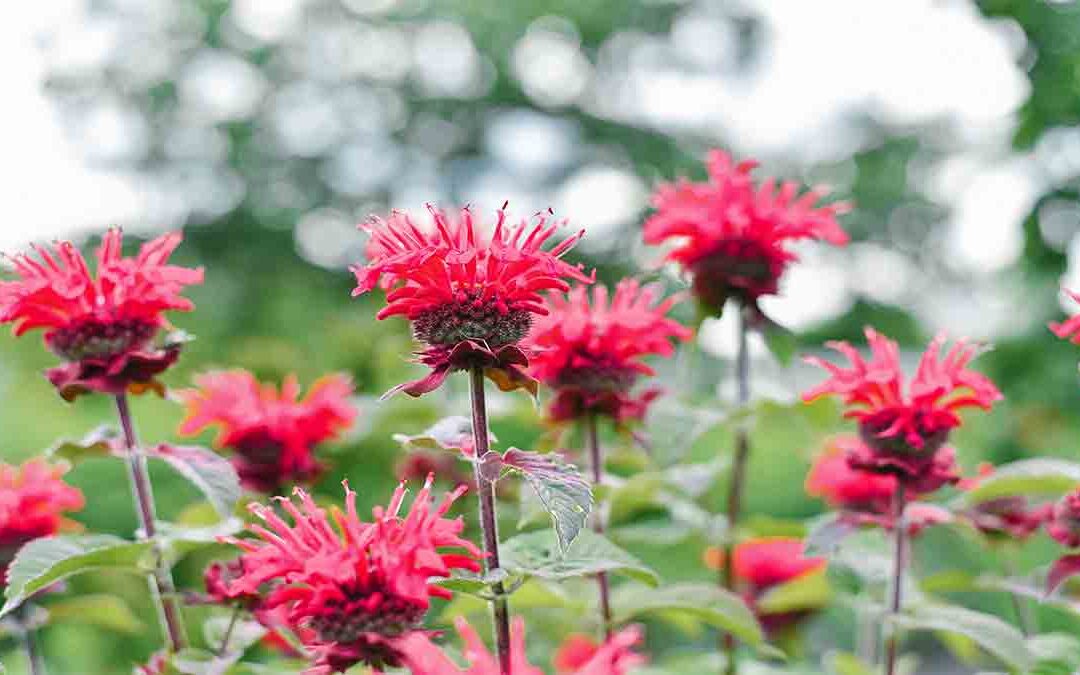Nurturing Your Bee Balm
| Factor | Bee Balm |
| Sunlight | Full sun (at least 6-8 hours per day) |
| Soil | Well-drained soil rich in organic matter. Slightly acidic soil preferred. |
| Water | Water regularly, especially during dry periods. Somewhat drought-tolerant once established. |
| Pruning | Deadhead spent flowers to encourage continuous blooming and prevent self-seeding. Cut back in late fall or early spring to promote new growth. |
Pro Tip: Provide good air circulation to prevent powdery mildew. Water at the base of the plant to avoid wetting the leaves.
Best Bee Balm Companion Plants
Purple Coneflower (Echinacea)
These tall, vibrant flowers create a stunning visual symphony alongside bee balm, attracting a diverse cast of pollinators.
Pro Tip: Divide clumps every 3-4 years to maintain vigor and encourage more blooms. Deadhead spent flowers to promote continuous flowering.
Black-Eyed Susans (Rudbeckia)
Inject a ray of sunshine into your garden with Black-Eyed Susans. Their cheerful yellow blooms complement bee balm perfectly and are a magnet for butterflies and bees.
Expert Tip: Provide support for taller varieties to prevent them from flopping over. Deadhead regularly to encourage a longer bloom period.
Yarrow (Achillea)
The delicate, feathery foliage of Yarrow provides a lovely contrast to bee balm’s bold blossoms. It attracts beneficial insects like ladybugs and lacewings, which help keep pests in check.
Pro Tip: Cut back plants by half after the first bloom to encourage a second flush of flowers. Divide clumps every few years to prevent overcrowding.
Catmint (Nepeta)
This low-growing, aromatic plant forms a beautiful ground cover around bee balm, attracting pollinators while repelling deer.
Expert Tip: Shear back plants after flowering to maintain a compact shape and encourage reblooming. Choose a variety that is known to be deer-resistant in your area.
Salvia
With its myriad of colors and textures, Salvia is a versatile companion for bee balm. Its tubular flowers are a favorite of hummingbirds and butterflies.
Pro Tip: Pinch back young plants to promote bushier growth and more flowers. Deadhead regularly to prolong the bloom period.

Purple Coneflower (Echinacea purpurea)
A classic pairing with bee balm, these tall, vibrant flowers create a stunning visual display and attract a multitude of pollinators. They are also drought-tolerant and deer-resistant, making them a low-maintenance choice.
Pro Tip: Deadhead spent flowers to encourage continuous blooming throughout the season. Divide clumps every 3-4 years to maintain plant vigor and promote new growth.
Russian Sage (Perovskia atriplicifolia)
The airy blue-gray foliage and delicate purple flowers of Russian sage provide a beautiful contrast to bee balm’s bolder colors. It’s a great choice for adding height and texture to the garden and attracts butterflies and bees.
Expert Tip: Prune back hard in early spring to encourage new growth and maintain a compact shape. Avoid over-fertilizing, as it can lead to leggy growth and reduced flowering.
Agastache (Anise Hyssop/Hummingbird Mint)
With its long spikes of colorful flowers and fragrant leaves, agastache is a favorite among hummingbirds and butterflies. It’s a relatively low-maintenance plant that thrives in full sun and well-drained soil.
Expert Tip: Deadhead spent flower spikes to promote continuous blooming. Agastache can self-seed readily, so consider removing seed heads if you don’t want it to spread.
Coreopsis (Tickseed)
These cheerful yellow flowers add a burst of sunshine to any garden and bloom profusely for a long period, attracting pollinators and providing a source of nectar throughout the season.
Expert Tip: Shear back plants by about one-third after the first flush of blooms to encourage a second wave of flowering. Coreopsis is generally low-maintenance and doesn’t require frequent fertilization.
Goldenrod (Solidago)
A late-season bloomer, goldenrod provides a crucial source of food for pollinators when other plants are fading. Its bright yellow flowers add warmth and visual interest to the autumn garden.
Expert Tip: Choose cultivars that are less likely to spread aggressively. Divide clumps every few years to maintain their size and vigor.
Asters
Available in a variety of colors, asters are another excellent late-season bloomer that provides nectar and pollen for pollinators preparing for winter. They create a beautiful backdrop for bee balm and other companion plants.
Expert Tip: Pinch back young plants in early summer to encourage bushier growth and more flowers. Stake taller varieties to prevent them from flopping over.
Milkweed (Asclepias)
A vital host plant for monarch butterflies, milkweed also attracts a variety of other pollinators. Its unique flowers and seed pods add visual interest to the garden and support a crucial part of the ecosystem.
Expert Tip: Choose a milkweed species native to your area to ensure it is well-suited to your local environment and supports the monarch butterfly population.
Lavender (Lavandula)
The fragrant purple flowers of lavender are a magnet for bees and butterflies. It’s a drought-tolerant and deer-resistant plant that thrives in full sun and well-drained soil. Its aromatic foliage also repels pests and adds a calming scent to the garden.
Expert Tip: Prune lavender plants back by about one-third after flowering to maintain their shape and encourage new growth. Avoid overwatering, as lavender prefers drier conditions.
Plants to Keep at a Distance from Bee Balm
- Mint: While fragrant and beneficial in its own right, mint can be invasive and compete with bee balm for resources. It’s best to plant it in containers or areas where it can be contained.
- Tomatoes: Although tomatoes and bee balm attract similar pollinators, they can also share pests and diseases. It’s wise to keep them separated in the garden to maintain their health.
- Roses: Roses have different growing requirements than bee balm and can attract pests that may harm your bee balm plants. It’s best to plant them in a separate area of the garden.
Designing a Bee Balm Paradise
- Pollinator’s Dream: Create a haven for pollinators by strategically combining bee balm with other flowering plants that bloom at different times throughout the season. Include a variety of flower shapes and colors to attract a diverse range of beneficial insects.
- Cottage Garden Charm: Bee balm’s informal growth habit makes it a perfect fit for a cottage garden. Combine it with other cottage garden favorites like hollyhocks, foxgloves, and delphiniums for a romantic and whimsical landscape.
- Border Brilliance: Plant bee balm along borders or walkways to showcase its vibrant colors and fragrant blooms. Combine it with other perennials like coneflowers, asters, and Russian sage for a colorful and textured display that will delight visitors and pollinators alike.
Frequently Asked Questions about Bee Balm Companion Plants
Q: Why are companion plants important for bee balm?
A: Companion plants can enhance the beauty of your garden, attract beneficial insects, deter pests, and improve the overall health and growth of your bee balm.
Q: Which plants should I avoid planting near bee balm?
A: It’s best to avoid planting mint near bee balm, as it can be invasive and compete for resources. Also, steer clear of tomatoes and roses, as they can attract pests and diseases that may harm your bee balm.
Q: Can I plant bee balm with other members of the mint family?
A: While bee balm is a member of the mint family, it doesn’t spread as aggressively as some other mints.
Q: Are there any specific bee balm varieties that are better suited to companion planting?
A: Generally, all bee balm varieties can benefit from companion planting. However, consider the mature size and growth habit of the specific variety when selecting companions. For example, taller varieties may need taller companions for support, while shorter varieties may be better suited to groundcovers.
Q: Do bee balm companion plants need the same growing conditions as bee balm?
A: Ideally, companion plants should have similar sunlight, soil, and water requirements as bee balm. This ensures they will thrive together and create a healthy and harmonious garden ecosystem.
Q: How can I prevent powdery mildew on bee balm?
A: Powdery mildew is a common issue for bee balm.
A: Some companion plants, such as catmint and lavender, have strong scents that deer tend to avoid.
Q: Can I grow bee balm in containers with companion plants?
A: Yes, you can grow bee balm in containers with companion plants. Choose a container that is large enough to accommodate the mature size of all the plants. Ensure proper drainage and provide adequate sunlight and water.
Q: Are there any companion plants that specifically attract butterflies to my bee balm garden?
A: Many of the companion plants mentioned in this guide, such as asters, milkweed, and lavender, are excellent at attracting butterflies. You can also add other butterfly favorites like butterfly weed, coneflowers, and zinnias to further enhance your garden’s appeal to these beautiful pollinators.
Q: How often should I fertilize my bee balm and its companion plants?
A: Generally, a light application of balanced fertilizer in spring is sufficient for bee balm and its companions. Avoid over-fertilizing, as it can lead to excessive foliage growth at the expense of flowers.
Read More: 20 Powerful Lantana Companion Plants

